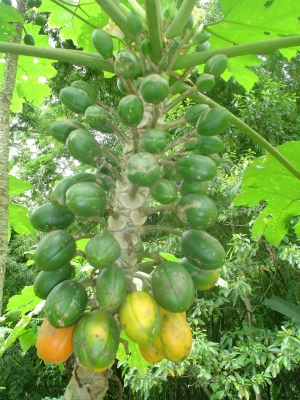Vasconcellea cauliflora
(Jacq.) A.DC.
Caricaceae
Carica boissieri (A.DC.) Hemsl.
Carica cauliflora Jacq.
Carica pennata Heilborn
Carica quinqueloba Sessé & Moc.
Papaya cauliflora (Jacq.) Poir.
Vasconcellea boissieri A.DC.
Common Name:

Fruits ripening along the trunk
Photograph by: John Ocampo

General Information
Vasconcellea cauliflora is a usually unbranched small, evergreen tree with a main stem up to 3.5 metres tall.
The edible fruit is gathered from the wild for local consumption. The plant is sometimes cultivated for its fruit.
Known Hazards
None known
Botanical References
Range
Northern S. America - Colombia, Venezuela; C. America - Costa Rica, El Salvador, Honduras, Guatemala; Caribbean - Trinidad and Tobago.
Habitat
Open areas and forest edges.
Properties
| Edibility Rating |      |
| Habit | Evergreen Tree |
| Height | 3.00 m |
| Cultivation Status | Cultivated, Wild |
Cultivation Details
Not known
Edible Uses
Fruit. The fruits are not eaten raw. However, the pulp of papaya d montana fruits is used by local people for making candy, jams, cakes, and salted preparations. Sherbets are also made from the pulp.
Medicinal
None known
Other Uses
None known
Propagation
Seed - sow in individual containers or in a nursery seedbed in light shade. Germination can be slow and difficult, taking about 30 days[
670- Title
- Study of the Cultivation Potential of Native Fruit Species in Loja Province, Ecuador
- Publication
-
- Author
- Scheldeman X.
- Website
- http://www.tropicallab.ugent.be/start.htm
- Publisher
-
- Year
- 0
- ISBN
-
- Description
- A partial study, published on the Internet, of the family Caricaceae, with some very good photographs. Also, some notes on the Cherimoya.
]. Seedlings can be planted out when 4 - 6 months old[
670- Title
- Study of the Cultivation Potential of Native Fruit Species in Loja Province, Ecuador
- Publication
-
- Author
- Scheldeman X.
- Website
- http://www.tropicallab.ugent.be/start.htm
- Publisher
-
- Year
- 0
- ISBN
-
- Description
- A partial study, published on the Internet, of the family Caricaceae, with some very good photographs. Also, some notes on the Cherimoya.
].
If you have any useful information about this plant, please leave a comment. Comments have to be approved before they are shown here.






 Useful Tropical Plants Database 2014 by
Ken Fern,
web interface by
Ajna Fern
with help from
Richard Morris.
Useful Tropical Plants Database 2014 by
Ken Fern,
web interface by
Ajna Fern
with help from
Richard Morris.